A Surfeit of Sulphides
I was fondling my rocks the other night -something I do often- gently touching them, stroking each one, talking to them like the fine old friends they are. My collection is growing, so mid Covid I bought some rickety, white Ikea Billy shelving to show off the best pieces in my home office, where nobody can see them but me. Mid-caress, my eyes were drawn to the 3 sulphide specimens perched on the top shelf which has begun to sag worryingly under the weight of sexy, coloured rocks.
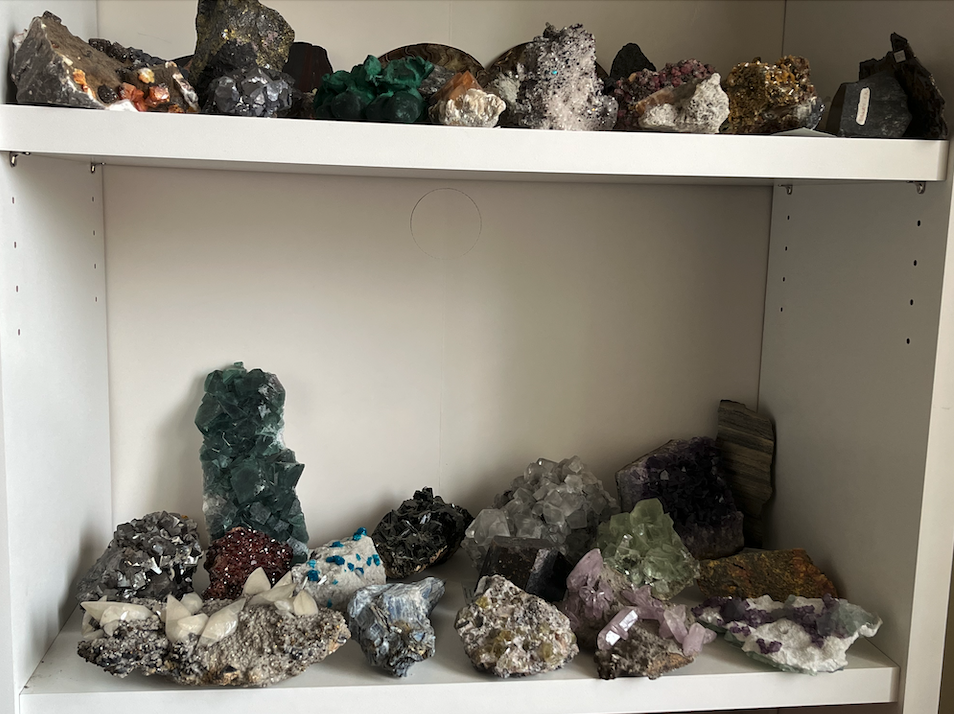
They’re 3 of my favourite samples: very different visually but closely related chemically. There’s some eye candy pyrite from Huanzala in Peru, a particular favourite; a wonderful chunk of arsenopyrite from Kosovo, and some meaty looking yellow-orange orpiment I collected in Iran. They represent points on a chemical spectrum with iron sulphide at one end, iron-arsenic sulphide in the middle and pure arsenic sulphide at the other end. Pyrite has cubic crystal structure, and orpiment and arsenopyrite are both monoclinic – an off-kilter matchbox shape.
At this point, the mineralogists out there will nerdily tell me that it isn’t that simple you idiot, and they’re right – there’s all sorts of pressure/temperature/chemical considerations that influence which mineral forms and when- but I like to think of them as a simple spectrum.
It’s All Metaphysical Bollocks
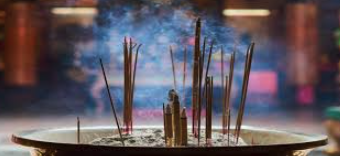
Type any mineral name into the Googleizer and -sadly- you’ll be met with a list of search terms about “meaning” “crystal benefits” or “spiritual properties” rather than the important sciency stuff. I’ve touched on the hyperbolic nature of crystal power descriptions before here and here. When I started collecting back in the ’70s, quartz was touted by some hippy shops for its “vibrations” and you might see a small bowl of quartz crystals next to the joss sticks and patchouli oil, but that was about it. Most minerals were just that: inorganic rocks that looked nice but did nothing useful and there was none of the inter-dimensional stupidity that pops up everywhere today. I got this gem of an introduction for pyrite’s magical powers:
“Despite its illustrious name (??despite??), Pyrite is actually an earth stone rich in iron sulfide – hewn from the far reaches of Namibia, the mystical heartlands of Peru, the golden mountains of Spain and Mexico, and the icy distances of Canada.”
I’d be quite proud of myself if I’d written that drivel.
Pyrite
Anyway, back to inorganic reality. My favourite chunk of pyrite comes from the Huanzala mine, in Ancash, Peru. It cost me a couple of hundred bucks via an online auction from Dan and his team at Weinrich Minerals. Huanzala is famous in collecting circles because it produces wonderfully shiny pyrite with a distinctive 8-sided pyramidal shape. Pyrite usually forms as cubes (see below), not octagonal pyramids, so Huanzala material is very collectible.
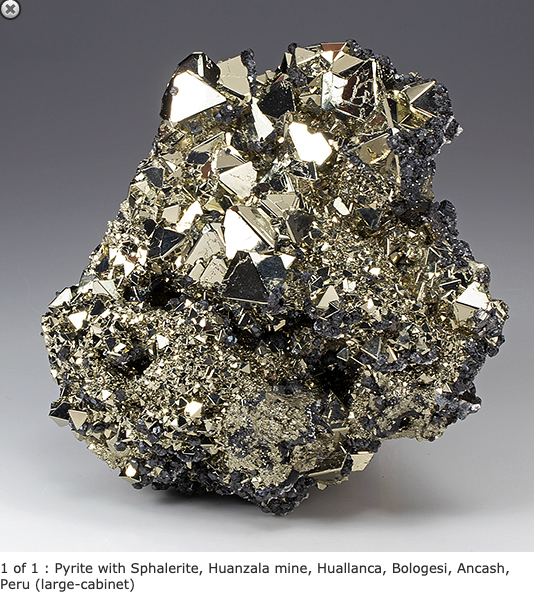
It’s so collectible that a lot of the miners at Huanzala used to spend their days stuffing samples into their lunch boxes to sell to dealers, neglecting their actual work which was mining zinc-lead ore. One source notes that Huanzala probably holds the world record for total tonnage of mineral specimens produced by a single mine. Things got so bad that the mine management eventually banned its workers from collecting and awarded a special contract to Gemrock Peru to act as the sole mineral collector and trader of samples from Huanzala. Lucky Gemrock.
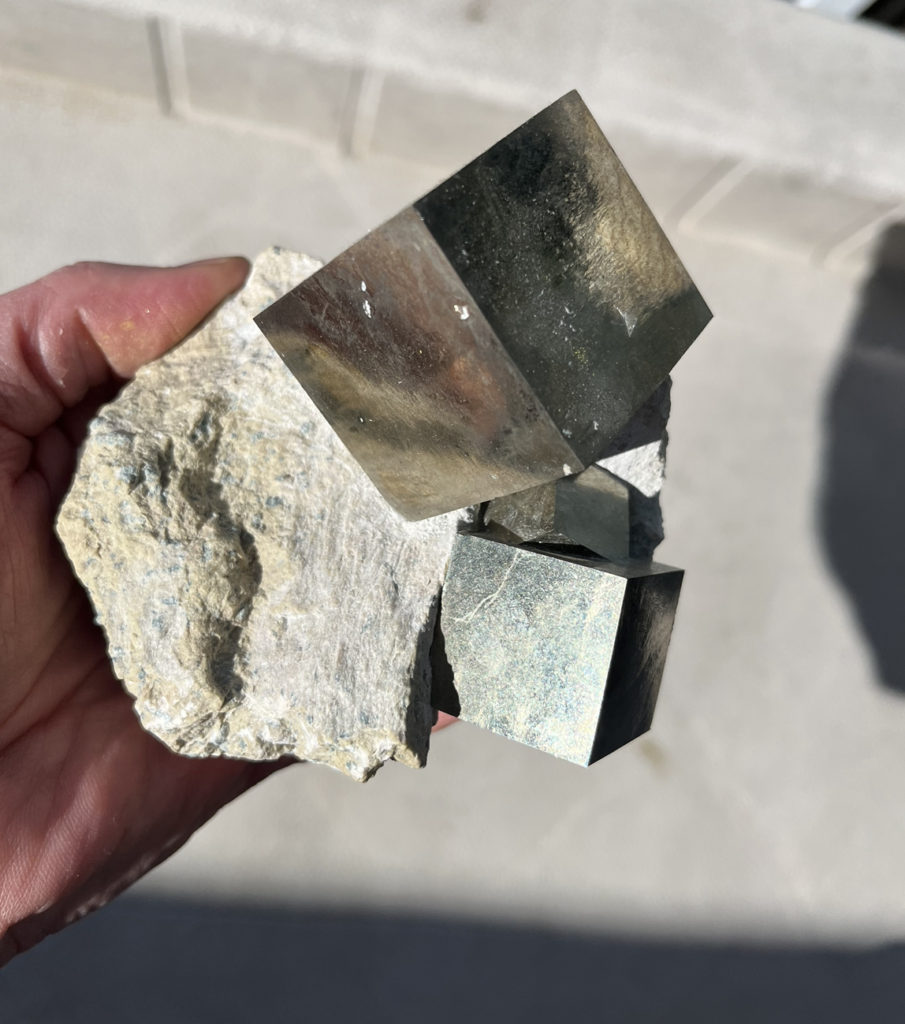
My other fondlesome pyrite sample comes from the unusual Mina Ampliación a Vitoria (the Victoria Mine) near Navajún in Spain, a unique location for the mineral. Navajún pyrite occurs as geometrically perfect cubes with knife sharp edges, hosted in a soft, marly sedimentary rock. I have 2 pieces from Navajún. The cubes are so regular that most people who see them assume that they’re man made and accuse me of lying when I tell them they’re 100% natural. Can you imagine a geologist ever lying to anyone? No, me neither.
Arsenopyrite
The other end of my chemical spectrum is occupied by arsenopyrite, an iron arsenic sulfide with a chemical composition of FeAsS (if you mix arsenic into the iron and sulphur rich hydrothermal fluid that pyrite forms from, you’ll probably get some arsenopyrite.) It’s dull metallic grey in colour and dense -a bit like me- and is often found in association with gold, hence exploration geologists love the stuff and shout “woohoo -arseno!” at the top of their squeaky nose-comber voices whenever they see its silver-grey glint. And also like me, it has quite a distinctive smell when bashed with a hammer; a definite garlicky whiff which all minerals’ geologists should recognize.


With a specific gravity of about 6, it’s noticeably heavier than both pyrite and orpiment. It’s also somewhat poisonous courtesy of the arsenic. You’re supposed to wear gloves while handling it – which nobody ever does – and avoid breathing in any dust but I’ve yet to meet a geologist who breaks out the rubber gear when they spot it. Quite the opposite. We actively ingest the stuff. Many geologists will instantly lick the suspect sample to get a clearer look at it under a fresh coat of bubbly sputum.
Bleeding and Hiccups
Despite our complacency, long-term exposure to arsenic does result in nerve damage and may also lead to lung, skin, or liver cancer. One of its most famous victims was probably Napoleon, the diminutive former emperor of France. His residence-in-exile on the windswept island of St Helena in the South Atlantic appears to have been riddled with enough arsenic to poison a small army, and one theory states that his nasty slow death -think bleeding, hiccups, vomiting, blood clots and thrombosis-of-something-bad- was a result of long term exposure to the metal.

I have a lovely piece of arsenopyrite (see pic below) that I bought from a dealer at the PDAC a few years back. It comes from the the consonant heavy Trepča Stari Trg Mine in the Trepča valley of Kosovo. Trepča was a complex of 40 different mines, shafts, and adits, and one of Europe’s biggest sources of lead and zinc with over 20,000 people grubbing around there at its peak. Aside from being a world-class location for drop dead sexy arsenopyrite samples, the area is known for the high level of contaminants including -yes you guessed it- arsenic, caused by years of mine dust and the massive 40-million tonne tailings’ dumps. Nowadays, production has been scaled back although substantial base metal resources remain to be mined.
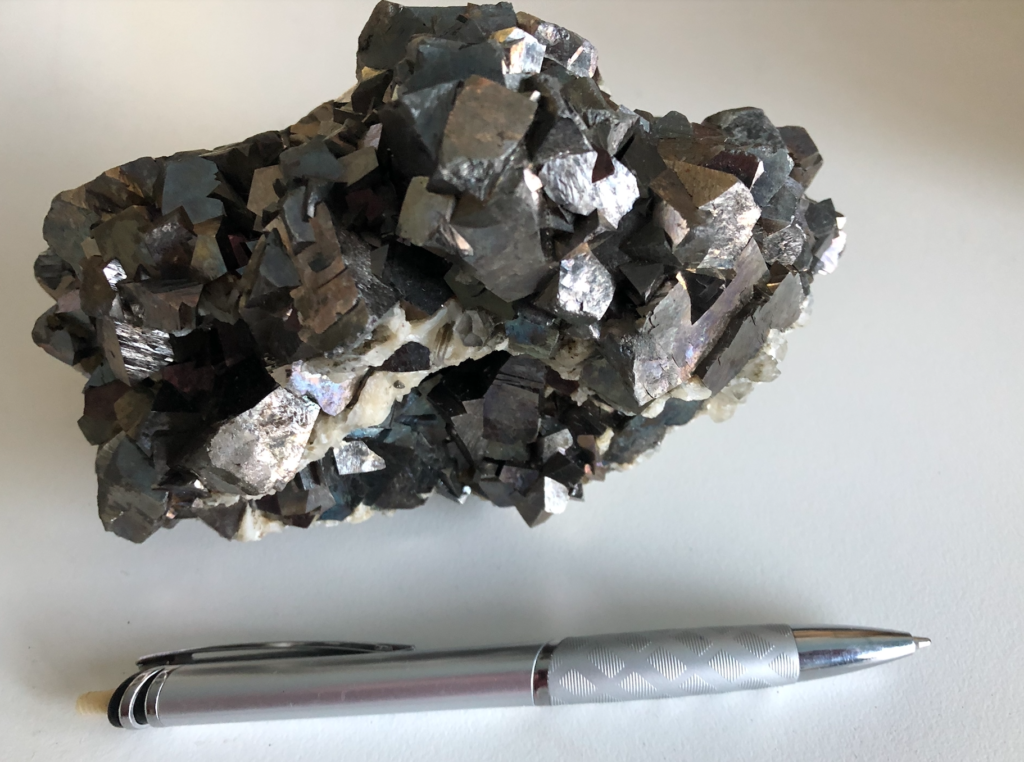

Toxic Karma
Arsenopyrite’s excessive toxic karma -the high likelihood of death by slow, bloody poisoning- leaves me a little confused because the metaphysical folk have come up with a much more positive spiritual spin on the mineral which is hard to reconcile with its hemorrhagic realities.
“Aligns with the Solar plexus, with some affect on Sacral and Root Chakras; balances all Properties: As with most arsenates, arsenopyrite’s energy has a warm and friendly quality. When you hold it, you can’t help but smile. It bestows inner warmth and lifts the spirits, and balances all chakras, leaving behind a golden glow. It activates the lower three Chakras, thereby strengthening self-confidence, motivation, and drive, and instilling a sense of empowerment, and can also help to stimulate the libido. Used in meditation, there is a multidimensional aspect, allowing you to experience several levels of existence at the same time, or travel between dimensions.”
I have absolutely no idea what any of that means but the last thing that would stimulate my libido is an image of Napoleon dying of terminal hiccups.
Orpiment
Our final mineral today is orpiment, an attractive bright yellow sulphide of arsenic. It’s soft, very soft, and has an almost micaceous cleavage; you can peel away thin sheets of shiny yellow-orange mineral if you want. The name means “gold paint” in Latin – an indication of its past utilization in paint and ink.
I own a few pieces that I collected myself in Iran at a place called Zarshuran, once the site of an active orpiment mine and now one of Iran’s only gold mines thanks in part to the extensive-but-doomed work done by our exploration team in the 1990s. Hand cobbed lumps of Zarshuran orpiment were exported to India where it was used as a pigment for the the small coloured dots known as Bindi that Hindu women put in the middle of their foreheads to signify that they’re being slowly poisoned by arsenic. It’s also used as a hair remover; when mixed with lime (calcium hydroxide not the citrus fruit) arsenic sulphide can remove the coarse hair from cow hides, which must be good for you, right?
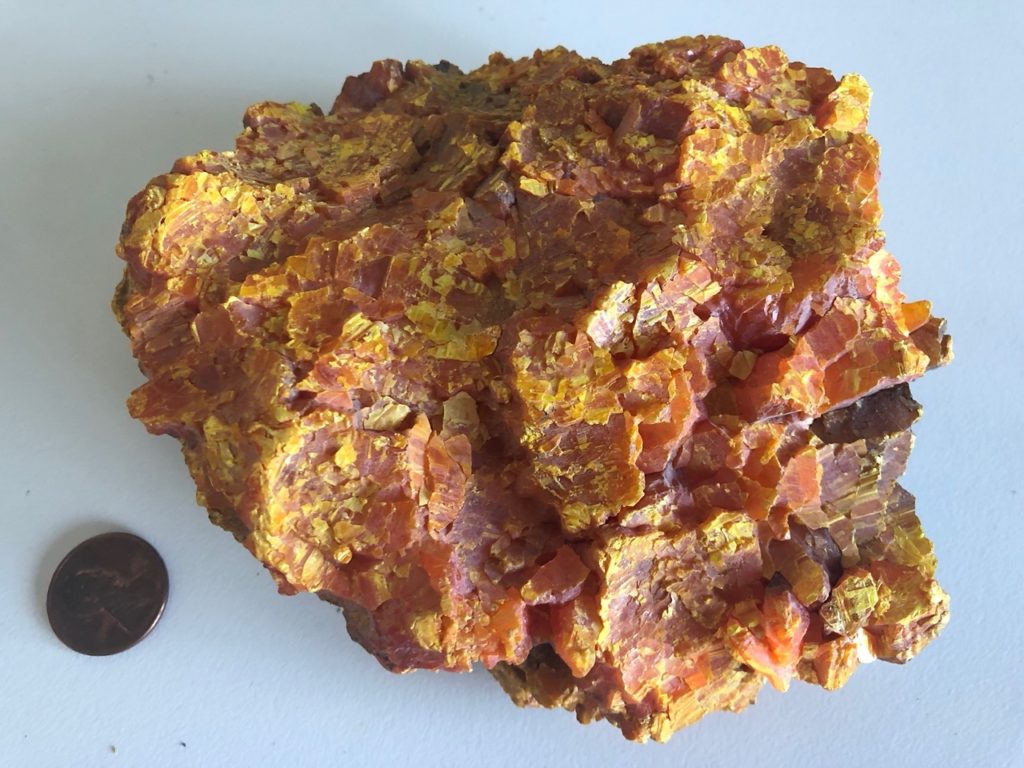
Boom
Orpiment was also mixed with gunpowder in fireworks to give the flames and sparks a yellow or white colour to distract the happy crowds below while they were sprinkled with arsenic-laden ash. Funny enough it’s not used for that anymore. The geologyscience.com website notes drily that “Safer and less toxic alternatives have been developed [instead of orpiment] for various purposes, particularly in the fields of art, chemistry, and industry” which basically covers everything it could ever have been used for other than chakra tickling.
Daylight Fading
Opiment is photosensitive and will develop a thin, powdery coating with time, like its closely related relative, the red arsenic mineral realgar (α- As 4S 4). I used to have a lovely piece of realgar but neglected to read the instructions on the box. If I had, I’d have noted that realgar also breaks down in daylight into a nice, yellow powder reminiscent of orpiment but which is definitely NOT the sample I bought from a Russian mineral dealer for $400 at the PDAC who wouldn’t look me in the eye when he handed me the box. Shifty bugger. Left on a shelf in full daylight, my sample of big, red realgar crystals dotted over quartz crystals enthusiastically turned itself a chunk of quartz covered in worthless yellow powder. And no, I haven’t learned my lesson.
And remember…
If boring stories about poisonous minerals turn your crank, boy have you come to the right place! One trait that all geologists possess is the ability to tranquilise a crazed bull elephant with a well-aimed anecdote of unparalleled dullness, and trust me, I will not disappoint! Sign up now using the plain subscription box near the top of this page and I guarantee you’ll sleep well tonight. Move over melatonin, Ralph’s in da house.

